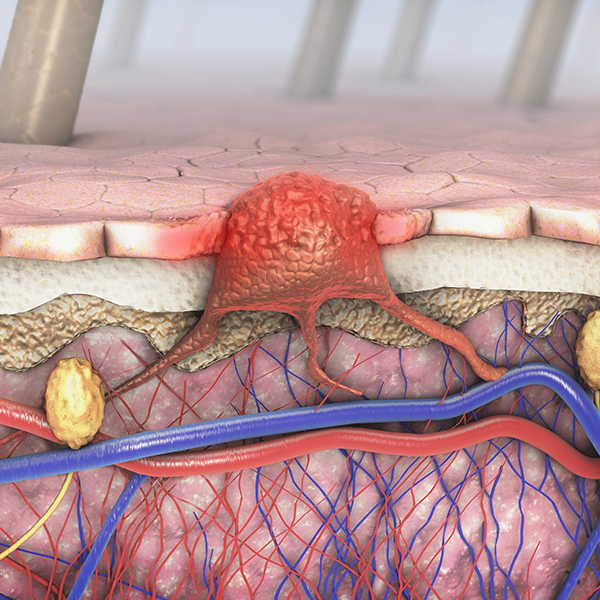-
When the shoelaces fray: short telomere syndromes
Article by Barbara Toman
 Unlike gray hair, one of the most significant signs of aging is invisible to the naked eye. Deep inside cells, at the tips of thread-like chromosomes, structures known as telomeres protect chromosomes from deterioration—a bit like the way caps at the ends of shoelaces prevent fraying. Telomeres naturally shorten as people age.
Unlike gray hair, one of the most significant signs of aging is invisible to the naked eye. Deep inside cells, at the tips of thread-like chromosomes, structures known as telomeres protect chromosomes from deterioration—a bit like the way caps at the ends of shoelaces prevent fraying. Telomeres naturally shorten as people age.
But sometimes, an inherited gene mutation causes telomeres to shorten at a faster rate. Abnormal telomere shortening results in accelerated-aging syndromes that affect many parts of the body and can occur in children or adults. The severity of short telomere syndromes varies, but they increase cancer risk and can lead to organ failure and death.
With help from the Center for Individualized Medicine, Mayo Clinic uses a precision-medicine approach to manage short telomere syndromes. Mayo's Premyeloid & Bone Failure Disorder Clinic provides diagnostic testing, multidisciplinary treatment and genetic counseling for short telomere syndromes.

"Short telomere syndromes have been recognized for several decades. But diagnosis has been very difficult because it requires highly specialized testing. With the advent of precision genomics, we have the opportunity to identify and manage these disorders, for the benefit of patients," says Mrinal Patnaik, M.B.B.S., a hematologist who directs the premyeloid disorder clinic.
Although short telomere syndromes are considered rare, Mayo Clinic sees five to seven people with the disorders a month. "We think short telomeres are much more common than has been reported, and anticipate that these new precision-medicine tools will bring a fair number of cases to light," Dr. Patnaik says.
'The mysterious telomere'
The 2009 Nobel Prize in medicine was awarded for discoveries about what the Nobel committee called "the mysterious telomere." Short telomeres affect parts of the body where stem cells actively divide, including bone marrow, skin and the tissues lining the lungs and digestive tract.
"These stem cells rely on telomeres to keep their integrity. Short telomeres cause the stem cells to prematurely die," Dr. Patnaik says.
Short telomeres can lead to scarring in the lungs and liver, narrowing of the digestive tract, bone marrow failure and immune-system deficiency. The severity of the inherited condition increases with each generation—a phenomenon known as genetic anticipation.
"Children inherit from their parents not only the genetic mutation causing short telomere syndrome but also shorter and shorter telomeres," Dr. Patnaik says. "As a result, the syndromes tend to occur at a younger age and with more severe manifestations in each generation. Eventually the life span is highly limited."
Initial diagnosis is a challenge because the signs and systems of short telomere syndromes are diverse. "There is a lack of awareness," Dr. Patnaik says. "A person with lung fibrosis and failing bone marrow might see a lung specialist or a blood specialist who isn't familiar with these multispecialty syndromes and doesn't put the clues together."
Mayo Clinic looks for certain signs and symptoms with unexplained causes, including:
- Personal or family history of premature graying of hair
- Low red blood cell, white blood cell or platelet counts
- Thickened, stiff or scarred lung or liver tissue
If short telomere syndrome is suspected, Mayo Clinic can arrange for sophisticated testing that measures the length of telomeres in an individual's blood cells. Once short telomeres are identified, Mayo Clinic has a genetic sequencing panel to help find the mutation causing short telomeres. If genetic sequencing doesn't uncover a mutation, whole exome sequencing—which looks at all disease-causing genes in an individual's DNA blueprint—can be performed.
Certain genetic mutations are known to be associated with short telomeres. But only 40 to 50 percent of people with short telomeres have one of these known mutations.
"The fact that more than half our patients with short telomeres do not have detectable gene mutations on sequencing panels indicates that we haven't yet discovered all the mutations that affect telomere length," Dr. Patnaik says. "There also may be nongenetic mechanisms involved—which is a Pandora's box we haven't even opened yet."
Seeking new treatment options
Recent research indicates that treatment with danazol, an anabolic steroid, may slow the rate of telomere shortening, as well as improve blood counts and stabilize lung and liver disease in people with short telomeres. Laboratory experiments with gene therapies are also underway. Mayo Clinic is involved in research efforts in both these areas.
"Unfortunately, while we increasingly understand the genetics and consequences of short telomeres, much work remains to be done with regards to effective treatment modalities," Dr. Patnaik says.
Transplantation can be an option for people who experience organ failure. However, individuals with short telomere syndrome often need multiorgan transplants: bone marrow transplantation as well as a liver or lung transplant, which makes the process extremely challenging.
"The vast majority of people with short telomere syndrome are turned down for transplant because not many centers are equipped to perform multiorgan transplantation," Dr. Patnaik says. "Our precision genomics clinic is working with the various transplant groups within Mayo Clinic to pursue safe multiorgan transplantation for these patients. At Mayo Clinic, we have a great opportunity to use precision medicine to benefit people with short telomere syndromes."
###
This post originally appeared on the Center for Individualized Medicine blog on Feb. 14, 2019.
Like this article? Register on Center for Individualized Medicine blog and get weekly updates on our new content.
Join the conversation
For more information on the Mayo Clinic Center for Individualized Medicine, visit our blog, Facebook, LinkedIn or Twitter at @MayoClinicCIM.
SAVOR, SUBSCRIBE, SHARE: Advancing the Science
- If you enjoyed this article, you might want to subscribe for regular updates.
- If you want to share this story with friends, social media links are at the top of the article.
- And if you want to see other recent stories on the blog, the index page is a great place to start.







